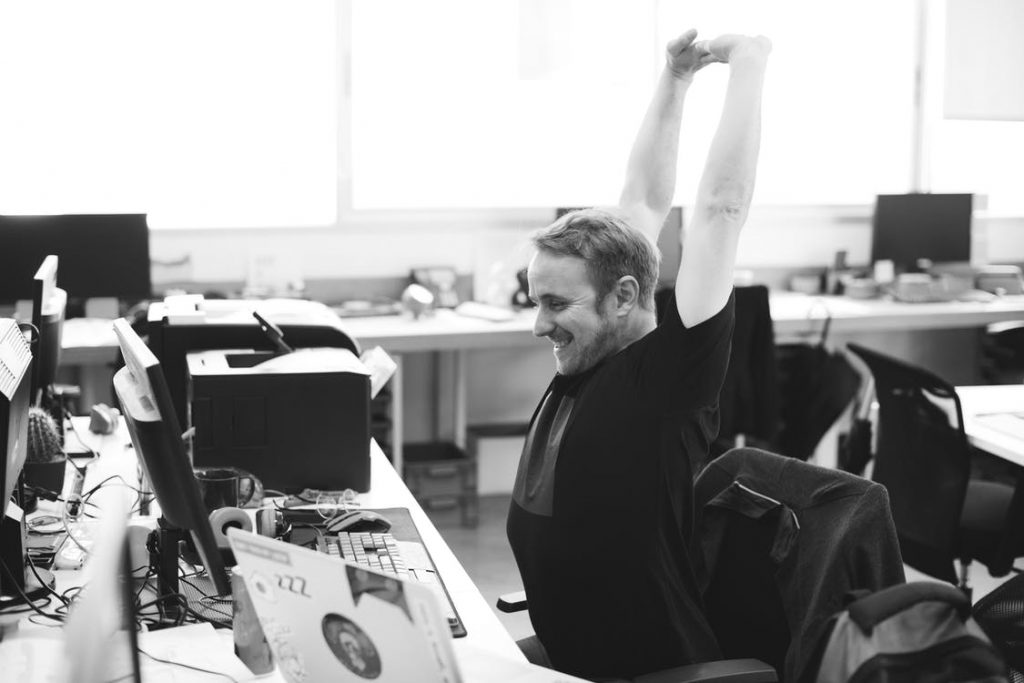Chances are you are one of the many Australians who are sedentary at work. Being sedentary and sitting for prolonged periods of inactivity, is one of the leading contributors of cardiovascular disease, diabetes, obesity and even premature mortality.
A recent report found that Australia is one of the most obese nations in the world. In 2017 in Australia alone; 4 million days of productivity were lost due to being overweight or obese equating to $3.6 billion!
Just How Much Time Do We Spend Sitting?
Ok, let’s do some simple math.
On average we spend eight hours at work each day. Stop for a 30-minute lunch and have two 15 minute breaks; that leaves a minimum of 7 hours a day we spend sitting.
Right, seven hours, multiply that by five days a week = 35 hours a week. 35 by 48 weeks a year; we’re up to 1,680 hours! That’s two and a half months every year we spend sitting at work. In a 45 year career, it turns out we will spend more than 80,000 hours seated. That’s over nine years! Yikes!
Surely It’s Not Really Killing Me?
Professor Dunstan from the University of Queensland’s School of Population Health explains how sitting is potentially killing us.
“When we are sitting, there are no muscle contractions. Muscle contraction helps the body’s efficiency to clear blood sugar levels and blood fat levels,” he says.
“Elevated glucose levels can lead to inflammation, which if repeated on a number of days or weeks, can lead to heart disease and, and a host of other conditions such as cancer.”
Time to Quit?!
I don’t mean to scare everyone into handing in their resignations, but it’s important to know that remaining sedentary at work is an epidemic. Remaining sedentary at work has caught the attention of the World Health Organisation all the way down to federal, state and local governments. The effects it has on our health, well-being and productivity are so great many organisations have jumped on the bandwagon and introduced some great day-to-day initiatives to counteract the ill-effects.
Save yourself!
We can blame our jobs all we want, but at the end of the day, we are in charge of our own health. Here are some simple changes you can make to your workday to keep your blood flowing.
Strut your stuff
Simply get up and walk! There are countless articles touting the benefits of the humble walk. You can increase your step count by parking your car further away; walk to a bathroom further way; go out for some fresh air during your lunch break; use a glass instead of a water bottle, so you consciously get up to refill. If you’re incredibly lucky and work in a place where they have a games room; challenge your colleagues to game of table-tennis or foosball. Want to up the ante? Five minutes of basketball will get your heart pumping.

Say a little prayer for me
Typing furiously to get your end of day report in can lead to micro-trauma and inflamed tendons in your wrist. However, simply praying could help alleviate the strain. Place your fingers and palms together with your hands in front of your chest, fingers pointing upward. While keeping your palms together and your elbows moving out, lower your hands until you feel a good stretch in your wrists. Hold for five seconds.”
Baby got back!
Sitting for prolonged hours especially while slumped back or slouched forward puts your back out of alignment and places unnecessary pressure on your back muscles and ligaments. Titled Sports Physiotherapist, Hardy Sattler who has worked with some great sporting teams including the Gold Coast Suns, Gold Coast Titans and the Australian Baseball Team recommends the following exercise: Stand up and place your hands on your heads. Bend your back backwards until you feel a stretch. Hold for five seconds.

Neck Minute
If your back is sore and your spine is out alignment; chances are you probably have a stiff neck too. Try this simple stretch: While standing or sitting upright, keep your spine straight and push your head forward, jutting your chin out as far as possible. Slowly reverse the movement by pulling your head back as far as possible, as if recoiling away from someone. Your head should stay level throughout the stretch, which you’ll feel at the base of your neck. Repeat up to four times.
To relieve tension in your neck and shoulders simultaneously, face forward, tilt your right ear down toward your right shoulder, leaving your left arm hanging straight down to increase the stretch. Hold for 20 to 60 seconds and repeat on the left side up to four times.
Eye Puns Couldn’t Be Any Cornea
Staring at a computer screen all day can lead to eye fatigue and dry eyes; particularly if your screen is positioned too close or too far making your eyes work harder to focus. Make sure your screen is distanced correctly; the top of the screen should be at eye level. Every 20-30 minutes give your eyes a break by looking at something in the distance for 20 seconds.
Wear glasses or contacts? Get a second ‘work pair’ that is prescribed according to the distance of your work monitor.
Just Keep Moving
We know that being sedentary at work can have serious ill-effects on our health, but there’s so much we can do to combat inactivity. Stretching at your desk, maintaining good posture and breaking up your day with a few short walks can go a long way. But if basketball, table-tennis and foosball sounds like a better way to break the mid afternoon lull at work, check out the current openings at HTG.
Thelma Lai
